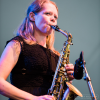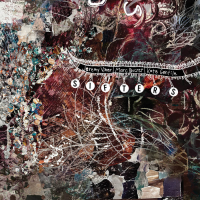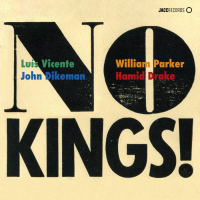Home » Jazz Articles » Album Review » Colette Michaan: Earth Rebirth
Colette Michaan: Earth Rebirth
Michaan is a native New Yorker of Egyptian-Syrian descent, a self-described "traveler" who is "crosscultural in my origins, history, identity, relations, and resonances." She has played with rural musicians in northern Thailand, Minangkabau saluang flutists in Sumatra, Iban musicians in Borneo, Rajastani desert and classical players in India, suling flutists in Indonesia, mbalax bands in Senegal, Gnawa and Andalusian players in Morocco, calypso and soca musicians in the Caribbean, and son bands in Cuba.
Earth Rebirth, Michaan's fifth album as a leader, reveals her deep roots in jazz. At age twelve, it was Eric Dolphy's voice on flute that first called her to the instrument and the idiom. In the late 1970s, she waited tables at the venerated Village Vanguard. "My three and a half years at the Vanguard were a wonderful time for me," she affirms. "Working there was a great musical education, as night after night I heard music that inspired me." Later, in the mid-1980s, she fell in love with the Cuban charanga and son traditions with which she has since been associated. Her releases reflect her depth and breadth as a flutist in the Latin jazz field and on global stages. (The YouTube below provides a taste.)
The album's outstanding penultimate track, Charles Mingus' "Reincarnation of a Lovebird," harks back to her childhood fascination with Dolphy. Mingus recorded the piece numerous times, often quite fast. Here, Michaan and her ensemble take metronome markings equivalent to his first recording of it (The Clown, Atlantic, 1957), albeit with a very different vibe. After an exploratory group improvisation, they adopt a medium Latin jazz feel, slowing down for a languorous interlude, then returning to the initial tempo. Following an inventive solo by Genovese, a son montuno is introduced and the flute takes a commanding flight, leading to a wonderfully warbling (bird)call-and-response.
Earth Rebirth is a beautiful mixture of jazz and Latin pieces, with a composition by Irakere flutist Orlando "Maraca" Valle, a lovely John Benitez arrangement of "El Raton," and a Concha Buika-inspired take on José Manuel Ortega Heredia's "Ni Contigo Ni Sin Ti." Abbey Lincoln's "Throw it Away," which has become a jazz standard, is particularly striking. Michaan heard Lincoln many times at the Vanguard, and seems to sing the lyric through her flute. Highly recommended.
Track Listing
Earth Rebirth; Campiña; El Raton; Ni Contigo Ni Sin Ti; Reincarnation of a Lovebird; Throw it Away.
Personnel
Colette Michaan
fluteLeo Genovese
keyboardsJohn Benitez
bassLuisito Quintero
percussionYusnier Sánchez Bustamante
percussionAdditional Instrumentation
Mireya Ramos: vocals (tracks 2, 3).
Album information
Title: Earth Rebirth | Year Released: 2023 | Record Label: Self Produced
Tags
PREVIOUS / NEXT
Support All About Jazz
 All About Jazz has been a pillar of jazz since 1995, championing it as an art form and, more importantly, supporting the musicians who make it. Our enduring commitment has made "AAJ" one of the most culturally important websites of its kind, read by hundreds of thousands of fans, musicians and industry figures every month.
All About Jazz has been a pillar of jazz since 1995, championing it as an art form and, more importantly, supporting the musicians who make it. Our enduring commitment has made "AAJ" one of the most culturally important websites of its kind, read by hundreds of thousands of fans, musicians and industry figures every month.
























